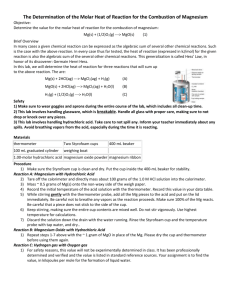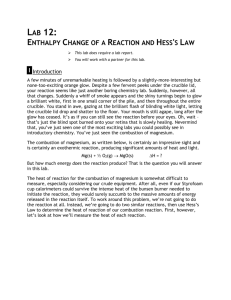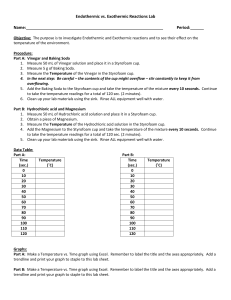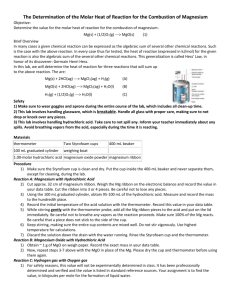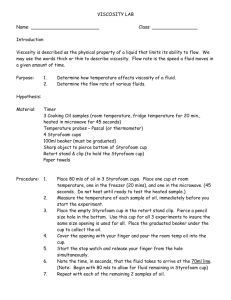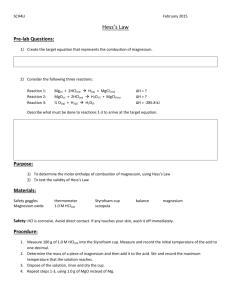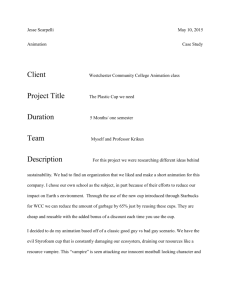Heat of Combustion Lab: Hess's Law & Calorimetry
advertisement
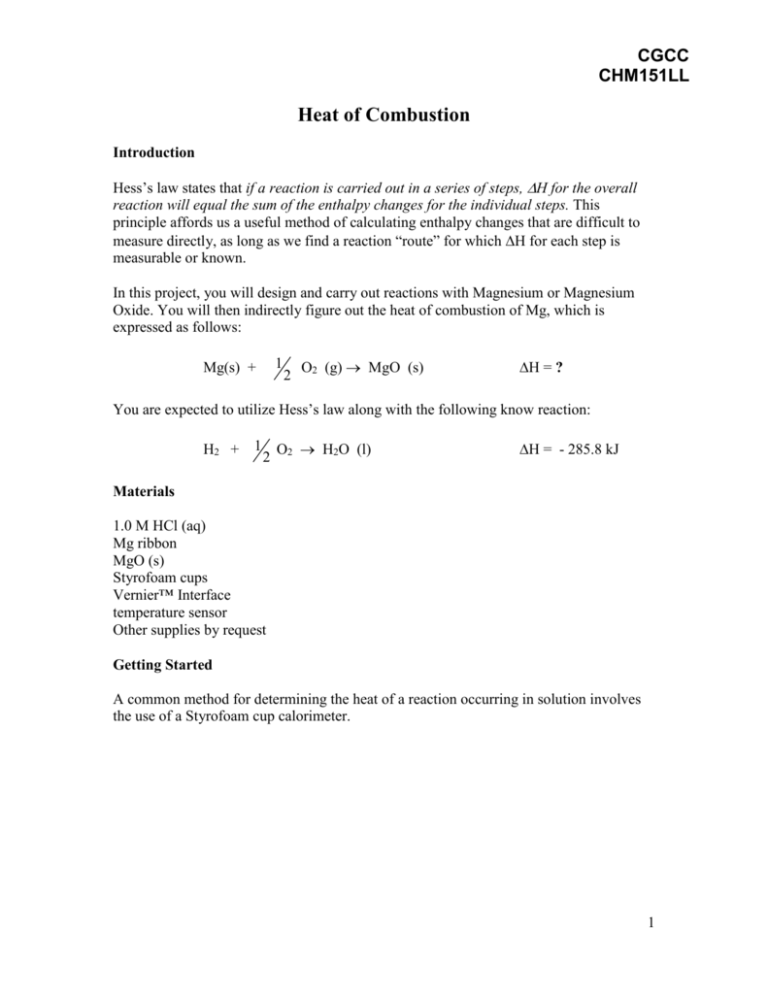
CGCC CHM151LL Heat of Combustion Introduction Hess’s law states that if a reaction is carried out in a series of steps, H for the overall reaction will equal the sum of the enthalpy changes for the individual steps. This principle affords us a useful method of calculating enthalpy changes that are difficult to measure directly, as long as we find a reaction “route” for which H for each step is measurable or known. In this project, you will design and carry out reactions with Magnesium or Magnesium Oxide. You will then indirectly figure out the heat of combustion of Mg, which is expressed as follows: Mg(s) + 1 2 O2 (g) MgO (s) H = ? You are expected to utilize Hess’s law along with the following know reaction: H2 + 1 O2 H2O (l) 2 H = - 285.8 kJ Materials 1.0 M HCl (aq) Mg ribbon MgO (s) Styrofoam cups Vernier™ Interface temperature sensor Other supplies by request Getting Started A common method for determining the heat of a reaction occurring in solution involves the use of a Styrofoam cup calorimeter. 1 Styrofoam cup Temperature Sensor Beaker For example, if NaOH (aq) and HCl (aq) were mixed in the cup above, an increase in solution temperature would be measured. Then, the heat absorbed by the solution can be calculated by using qsoln = masssoln * specific heat capacitysoln * Tsoln. Furthermore, one could figure out the heat released by the reaction in this case and eventually the molar heat of reaction, as well. Notice that we usually assume the specific heat capacity of a dilute solution to be that of just water, which is 4.184 J/ g∙ 0C. Also notice that it is assumed that there is no (or negligible) heat exchange with the surroundings though the Styrofoam cup or lid. You should observe a reaction before you decide to measure the heat of reaction to make sure that you have selected appropriate conditions to make a heat measurement. Such as appropriate temperature changes and making sure important reagents for answering the lab question are the limiting reagents. Report The lab report should be brief and to the point, and should be readable, both grammatically and stylistically. Reports must be typed. Although, neatly hand-written calculations, equations and diagrams are always permitted. This lab report should include all pertinent data collected to determine the heat of combustion of magnesium metal. The H value should be reported in kJ/mol. The general format of our lab report is given below and in the syllabus: Introduction: This should contain a clear statement of the problem, its goals, and your general approach to solving the problem. A typical introduction might be a short paragraph in length. Experimental: Enough detail should be given in this section so that someone else, not otherwise familiar with the work, could repeat the experiments. (a) You must identify all materials used. Include any information you have on the purity and concentrations of the materials. You should list reagents, give formulas of all compounds. (b) List equipment used. For specific equipment that is not commonly used, you should describe the apparatus, with a drawing, if necessary. 2 (c) Include a description of how the work was done. For experiments involving established procedures, reference to the appropriate source of the procedure may suffice. You should include all the background data, equations, and formulas necessary to the experiment. Results and Discussion: For most reports, the presentation of the results and the discussion of their significance may be separated into the following sections: (a) The major experimental results, including the original data, the calculated results, and one detailed sample calculation showing how the final results were obtained should be presented (You need not show repetitive calculations). It may be appropriate to include the theory behind your calculations. Include only relevant data and introduce equations, figures, graphs, and tables where necessary for clarity. All numerical data should be reported in accepted, self-consistent systems of units. (b) Report the precision of the work; theoretical values, if known; and the relative error of the experimental result. If your results differ significantly from expected values, or if the precision is worse than should be obtained with your procedure, discuss the possible sources of error in detail. (c) In the discussion of the significance of the results, an objective explanation is essential: You should point out the limitations of the work. You should also interpret, compare, and contrast your results with reports available from other sources. Try to correlate your results with the chemical principles or reactions involved. 3
